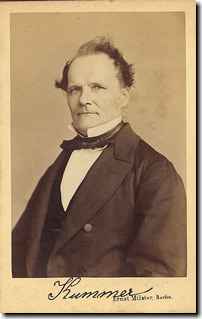- Ernst Kummer
Infobox_Scientist
box width = 300px
name = Ernst Kummer
 |300px
|300px
image_width = 220px
caption = Ernst Eduard Kummer
birth_date = birth date|1810|1|29|df=y
birth_place =Sorau ,Brandenburg ,Prussia
death_date = death date and age|1893|5|14|1810|1|29|df=y
death_place =Berlin ,Germany
residence =
nationality =
field = Mathematician
work_institution =University of Berlin University of Breslau
Gewerbeinstitut
alma_mater =University of Halle-Wittenberg
doctoral_advisor =Heinrich Scherk
doctoral_students =Georg Frobenius
Lazarus Fuchs
Hermann Schwarz Georg Cantor
nowrap|Hans Carl Friedrich von Mangoldt
known_for =Bessel function s
prizes =
religion =
footnotes =Ernst Eduard Kummer (
29 January 1810 -14 May 1893 ) was a Germanmathematician . Highly skilled inapplied mathematics , Kummer trained German army officers inballistics ; afterwards, he taught for 10 years in a "Gymnasium" (the German equivalent of high school), where he inspired the mathematical career ofLeopold Kronecker .Kummer was born in
Sorau ,Brandenburg (then part ofPrussia ). He retired from teaching and from mathematics in 1890 and died three years later inBerlin .Contributions to mathematics
Kummer made several contributions to mathematics in different areas; he codified some of the relations between different
hypergeometric series (contiguity relations). TheKummer surface results from taking the quotient of a two-dimensionalabelian variety by the cyclic group {1, −1} (an earlyorbifold : it has 16 singular points, and its geometry was intensively studied in the nineteenth century). See alsoKummer's function ,Kummer ring andKummer sum .Kummer and Fermat's last theorem
Kummer also proved
Fermat's last theorem for a considerable class of prime exponents (seeregular prime ,ideal class group ). His methods were closer, perhaps, to p-adic ones than to ideal theory as understood later, though the term 'ideal' arose here. He studied what were later calledKummer extension s of fields: that is, extensions generated by adjoining an "n"th root to a field already containing a primitive "n"throot of unity . This is a significant extension of the theory of quadratic extensions, and the genus theory ofquadratic form s (linked to the 2-torsion of the class group). As such, it is still foundational forclass field theory .Kummer surface
Kummer also found the Kummer surface, which is a special case of
André Weil 'sK3 surface s (named after the peak in theHimalayas discovered around the time of Weil's work. Another explanation is that K3 stands for the trio of mathematicians Kummer, Kodaira, and Kähler). K3 surfaces are theCalabi-Yau manifold s of dimension two, and have played an important role instring theory .References
* Eric Temple Bell, "Men of Mathematics", Simon and Schuster, New York: 1986.
* R. W. H. T. Hudson, "Kummer's Quartic Surface", Cambridge, [1905] rept. 1990.
* "Ernst Kummer," in "Dictionary of Scientific Biography", ed. C. Gillispie, NY: Scribners 1970-90.
External links
*
* [http://primes.utm.edu/notes/proofs/infinite/kummers.html Mathworld, proof of infinite number of primes]
* [http://fermatslasttheorem.blogspot.com/2006/01/ernst-eduard-kummer.html Biography of Ernst Kummer]Persondata
NAME= Kummer, Ernst
ALTERNATIVE NAMES=
SHORT DESCRIPTION= German Mathematician
DATE OF BIRTH=29 January 1810
PLACE OF BIRTH=Sorau ,Brandenburg ,Prussia
DATE OF DEATH=14 May 1893
PLACE OF DEATH=Berlin ,Germany
Wikimedia Foundation. 2010.
